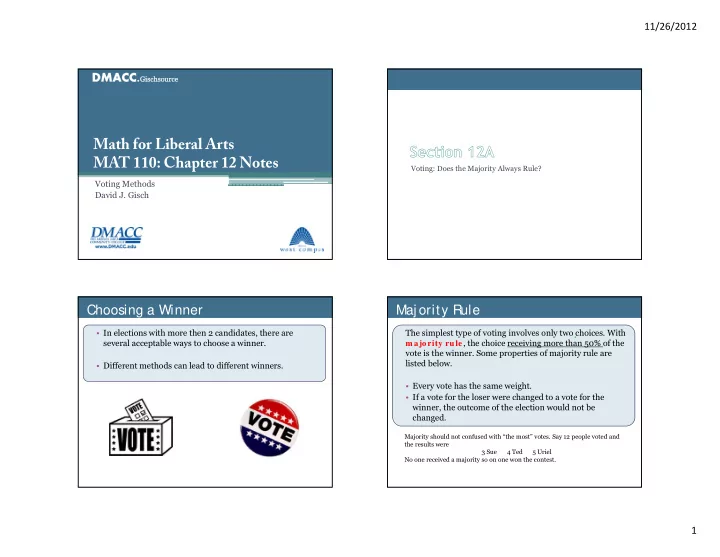

11/26/2012 Math for Liberal Arts MAT 110: Chapter 12 Notes Voting: Does the Majority Always Rule? Voting Methods David J. Gisch Choosing a Winner Maj ority Rule • In elections with more then 2 candidates, there are The simplest type of voting involves only two choices. With several acceptable ways to choose a winner. m ajority rule , the choice receiving more than 50% of the vote is the winner. Some properties of majority rule are listed below. • Different methods can lead to different winners. • Every vote has the same weight. • If a vote for the loser were changed to a vote for the winner, the outcome of the election would not be changed. Majority should not confused with “the most” votes. Say 12 people voted and the results were 3 Sue 4 Ted 5 Uriel No one received a majority so on one won the contest. 1
11/26/2012 Mathematics and Politics Variations on Maj ority Rule Table 12.1 shows the official results of the 2000 U.S. In some cases, a candidate or issue must receive more than presidential election. a majority of the vote to win ─ such as 60% of the vote, 75% of the vote, or a unanimous vote. In these cases, a super What was Bush’s m ajority is required. percentage of the • A 60% super majority is required to end a filibuster in the popular vote? U.S. Senate. 50,456,002 105,405,100 0.4787 47.87% • A 2/3 super majority is required by both the House and Senate to amend the U.S. Constitution. What was Gore’s percentage of the popular vote? Settled by majority rule of electoral votes 50,999,897 105,405,100 0.4838 48.38% rather than by popular vote. Maj ority Rule Plurality Method Example 12.A.1: Use the preference table below to Plurality m ethod : The candidate with the most first- determine who won using majority rule. place votes wins. • Notice it said most, not majority. 2
11/26/2012 Plurality Method S ingle Runoff Example 12.A.2: Use the preference table below to Single (top-two) runoff m ethod : The two candidates determine who won using plurality method. with the most first-place votes have a runoff. The winner of the runoff is the winner of the election. • When using a preference table you do need a runoff. You simply eliminate candidates and “move” the votes up. S ingle Runoff S equential Runoff Example 12.A.3: Use the preference table below to Sequential runoff m ethod: A series of runoffs is held, determine who won using single runoff method. eliminating the candidate with the few est first-place votes at each stage. Runoffs continue until one candidate has a m ajority of the first-place votes and is declared the winner. • When using a preference table you do need a runoff. You simply eliminate candidates and “move” the votes up. 3
11/26/2012 S equential Runoff S equential Runoff Slide 12-15 S equential Runoff Borda (points) Point system (Borda count): Points are awarded according to the rank of each candidate on each ballot (first, second, third, …). The candidate with the most points wins. Say we had a ballot with first, second, third, and fourth. 1 st = 4 points 2 nd = 3 points 3 rd = 2 points 4 th = 1 point 4
11/26/2012 Borda Count (Points) Condorcet (one-on-one) Method of pairwise com parisons (Condorcet m ethod): The candidate who wins the most pairwise (one-on-one) contests is the winner of the election. • You can use the preference ballot to make the comparisons. A = 5(18) + 1(12) + 1(10) + 1(9) + 1(4) + 1(2) = 127 B = 1(18) + 5(12) + 4(10) + 2(9) + 4(4) + 2(2) = 156 C = 2(18) + 2(12) + 5(10) + 4(9) + 2(4) + 4(2) = 162 D = 4(18) + 3(12) + 2(10) + 5(9) + 3(4) + 3(2) = 191 E = 3(18) + 4(12) + 3(10) + 3(9) + 5(4) + 5(2) = 189 Pairwise Comparison Voting Methods with Three or More Choices • Plurality m ethod: The candidate with the most first-place A vs. B votes wins. • Single (top-two) runoff m ethod: The two candidates with the most first-place votes have a runoff. The winner of the A vs. C runoff is the winner of the election. • Sequential runoff m ethod: A series of runoffs is held, eliminating the candidate with the few est first-place votes at A vs. D B vs. D B vs. E each stage. Runoffs continue until one candidate has a m ajority of the first-place votes and is declared the winner. • Point system (Borda count): Points are awarded according A vs. E C vs. D C vs. E to the rank of each candidate on each ballot (first, second, third, …). The candidate with the most points wins. • Method of pairwise com parisons: The candidate who wins B vs. C D vs. E the most pairwise (one-on-one) contests is the winner of the election. 5
11/26/2012 Winner •Everyone •Is •A •Winner 6
Recommend
More recommend